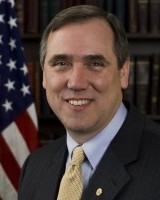On Tuesday, a bipartisan group of senators met with Barack Obama at the White House to discuss opportunities for progress on an energy bill. As has been true many times over the session, Sen. Jeff Merkley (D-Ore.) was in the room calling for ambition. In the last month, Merkley has pushed for a price on carbon, introduced a bill to reduce oil use, and introduced a plan to boost energy efficiency. He will introduce his own energy-independence legislation in the next week or two.
I called him afterwards to chat about the meeting and the state of energy politics.
——
Q. From news reports about the meeting today at the White House, it sounds like supporters of putting a price on carbon reiterated their support, Obama reiterated his support, and those who opposed it reiterated their opposition. So, where does that leave us?
A. Well, I came away with a good feeling. What you described is accurate, but as I was listening to the Republican senators who were present — they are engaged on energy. There’s a range of ways we could put a price on pollution, and that can range from Kerry-Lieberman applied only to utilities, to some sort of price directly on pollution, or some other form of subsidy for non-carbon [energy], which is another way to create a price differential, which is really what we’re talking about.
Susan Collins [R-Maine], working with Maria Cantwell [D-Wash.], has injected a significant idea into the debate. It says, “Yes, let’s put a price on carbon, but let’s not create regional disparities.” So the funds that are paid on carbon stay in the state where they are generated. States that put more in get more back; their families get more back.
That is the CLEAR [Carbon Limits and Energy for America’s Renewal] bill. It’s getting more attention. Maria did a presentation to the caucus last week, and the fact that she and Susan were there today — it just keeps getting brought up. People realize the resistance to the framework in Kerry-Lieberman. They’re looking for other ways to get this done. There are many ways to skin a cat.
Q. Isn’t part of the reason Kerry-Lieberman ended up hundreds of pages long is that they did a lot of work to address those regional disparities, via allowance revenue?
A. [Pause.] Yeah, it is an extremely complicated plan. We have to look for strategies that are simpler, easier explained to the public, and less subject to looking like every special interest has been taken care of.
Q. The quotes I’m hearing post-meeting from senators like Olympia Snowe [R-Maine] and Blanche Lincoln [D-Ark.] are, “We cannot put a price on carbon during an economic downturn, full stop.” It seems as if opponents have completely dug in their heels and proponents are doing all the compromising. How do you put the brakes on that dynamic?
A. Let me just share my opinion on this. If you structure a bill which will create a million jobs — which we can do — and you structure a bill which creates a path for ending our dependence on foreign oil — which we can do — and you put in a “polluter pays” structure which is somewhat simpler that Kerry-Lieberman structure … we have a chance of passing that. I think you go to the floor and you have the fight. You can’t run up the white flag until you have the fight.
Q. After last week’s caucus meeting, Democratic senators seemed quite energized. The idea was: we’re going to put all this stuff together into one big bill and make it impenetrable. We’re going to the floor with it and we’ll fight for 60 votes there.
A. You’re describing very much what I’m talking about. That’s certainly the strategy I favor.
Q. That unanimity and resolve already seem to be fraying at the edges. Do you think that’s going to be the strategy going forward?
A. I certainly hope the strategy will be to have a bill that addresses our dependence on oil and creates a strategy for polluters to pay, because Americans can wrap their hands around that.
You are drawing attention to the fact that the discussion at the caucus was different than the discussion today. That’s logical. It’s a different audience; it’s a different set of people in the room. This gave the president a chance to make his pitch. He thinks putting a price on pollution is an important part of our strategy. It worked tremendously well with acid rain. It was a Republican idea, rather than the Democratic strategy of putting a limit on every smokestack.
The president says this is an important chance to listen to people, to know where the challenges are and help craft a followup. Certainly I and many others are going to keep pressing for a bill that will be right for America, and carry that battle before the Senate.
Q. Everybody’s worried about the deficit. There are PAYGO [pay as you go] rules in place in the House and the Senate. The price on carbon is what pays for all the energy stuff; an energy-only bill will raise the deficit. Why isn’t the fiscal aspect a bigger part of the debate?
A. The partial answer to your question is that we’ve been so absorbed with health care and financial reform that this hasn’t been on center stage. It will be in center stage very shortly and there’s going to be a dialogue at every level, and by that I mean interest groups holding forums, running Capitol Hill visits, cranking up programs and mailing lists, and utilizing the full power of the internet.
Q. That’s going to happen?
A. That’s what is going to have to happen for this to succeed. Will it happen? I don’t know. I’m sure hoping that, just as when we turned from health care to financial reform, all kinds of groups jump in. We have to get the national conversation cranked up on energy.




